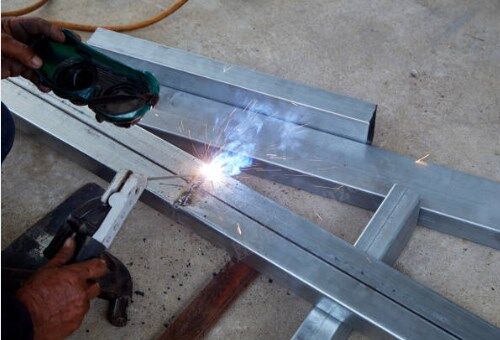Aluminum is a sought-after material in modern fabrication, widely used in industries such as automotive, aerospace, marine, and cryogenic piping due to its lightweight properties, excellent strength-to-weight ratio, and resistance to low-temperature brittleness. However, the very characteristics that make aluminum desirable also make it difficult to weld—especially using the GTAW (Gas Tungsten Arc Welding) process, commonly referred to as TIG welding.
In the realm of aluminum TIG welding, quality and visual appeal often outweigh speed and volume. Whether you're building custom components or working in high-end structural or decorative applications, mastering TIG welding aluminum is essential for fabricators aiming for precision, durability, and that signature "stacked dimes" appearance.
This aluminium TIG guide explores essential practices, settings, and considerations to help welders refine their skills and navigate the challenges of TIG welding aluminum—while also addressing critical decisions like aluminum TIG welding AC or DC, amperage control, arc balance, and more.

The Unique Challenge of TIG Welding Aluminum
Aluminum presents several welding challenges. Its high thermal conductivity draws heat away quickly from the weld puddle, requiring a higher heat input than steel. At the same time, aluminum is coated in a tough oxide layer that melts at approximately three times the temperature of the base metal, complicating puddle visibility and weld penetration.
Unlike gas metal arc welding (GMAW), which begins feeding filler metal immediately after trigger activation and often struggles with “cold starts,” TIG welding aluminum allows the operator to establish a puddle before introducing filler. This leads to improved fusion and control—at the cost of requiring greater operator skill and precise coordination.
1. AC or DC? Choosing the Right Polarity for Aluminum TIG Welding
The most common question in aluminum TIG welding is whether to use AC or DC polarity. The answer is clear: AC is essential for welding aluminum using TIG. This is due to the oxide layer that forms on aluminum’s surface, which can obstruct puddle visibility and hinder fusion if not properly removed.
Alternating Current (AC) reverses polarity back and forth during welding. The EP (electrode positive) cycle provides a cleaning action that breaks up the oxide layer, while the EN (electrode negative) cycle delivers the majority of the welding heat into the workpiece. Without this back-and-forth cleaning action, the weld can be compromised by oxide contamination.
Key takeaway: For anyone using an aluminium welder TIG machine, ensuring AC polarity is critical to success.
2. Mastering Balance Control for Cleaner Welds
Modern aluminum TIG machines include balance control features that allow welders to fine-tune the ratio of cleaning (EP) to welding (EN) during AC cycles. The standard factory setting on many machines is 75% EN and 25% EP—providing a good balance of penetration and oxide removal.
If you observe black flecks or “peppering” in the weld puddle, it may be a sign that the cleaning action isn’t sufficient. Reducing EN and increasing EP can help. However, excessive EP can overheat the tungsten electrode, causing it to ball and destabilize the arc.
Tip: Use balance control to optimize weld clarity and cleanliness without compromising tungsten shape and arc control.
3. Adjust AC Output Frequency for Precision Control
The AC output frequency—not to be confused with high-frequency arc starting—defines how many times per second the polarity switches between EN and EP. A higher output frequency creates a more focused, narrow arc cone, improving precision and control. Lower frequencies widen the arc and can be helpful for broader weld bead profiles.
For thin materials or welds requiring tight control, set AC frequency between 150–250 Hz.
For thicker materials (e.g., 3/8" and up), a frequency between 80–120 Hz helps establish wider beads and deeper fusion.
Recommendation: Adjust output frequency depending on the joint type and material thickness to ensure better control and minimize defects.
4. Use the Right Amperage: A Rule of Thumb
In aluminum TIG welding, correct amperage is a balance between effective penetration and avoiding burn-through. A widely accepted rule of thumb is to use 1 amp per thousandth of an inch of material thickness. For instance:
However, on thicker aluminum plates, you may not need to scale linearly. For example, welding 3/8" material often requires around 280 amps instead of 375, due to better heat retention once the weld begins.
Also consider the joint geometry—T-joints often require more heat than butt joints because heat dissipates in three directions instead of two.
5. Independent AC Amperage Control: A Game-Changer
Some advanced aluminium welder TIG machines allow welders to independently set amperage levels for the EN and EP cycles. This means:
For instance, you might use 300 amps during EN and 200 amps during EP. This independent control provides a way to improve weld integrity while preserving electrode life and weld directionality—especially helpful in high-amperage applications.
6. Adding Filler Metal for the “Stacked-Dimes” Look
The aesthetic hallmark of high-end TIG welding aluminum is the stacked-dimes appearance. Achieving it involves deliberate and rhythmic filler metal addition.
Filler rod introduces solid material into a molten puddle, which requires energy to melt and slightly cools the puddle. This controlled cooling helps solidify each "dab" into a defined ripple. More filler per dab creates more pronounced ripples; less filler results in smoother beads.
Some welders also use foot pedal modulation in sync with dabbing to create variations in puddle intensity and bead texture.
Insight: The stacked-dimes effect isn't just about looks—it reflects precise thermal management and deposition control.
7. Safety and Visibility: Don’t Overlook PPE
Even though GTAW is a clean process with no spatter, aluminum TIG welding still produces an intense arc and significant radiant energy due to aluminum’s reflectivity and high welding currents. Full personal protective equipment (PPE) is mandatory:
Modern helmet technology with true color or high-definition lenses helps distinguish puddle features and reduces eye fatigue—critical for long weld sessions and precision work.
Final Thoughts: Success in TIG Welding Aluminum Is in the Details
Mastering aluminum TIG welding requires not only technical understanding but a sharp eye for detail and consistent technique. From setting aluminum TIG welding AC or DC polarity (always AC!) to adjusting frequency, amperage, and balance, every parameter influences the quality and appearance of the weld.
Operators aiming to improve their skills should treat this aluminium TIG guide as both a reference and a foundation for experimentation. With practice, patience, and proper setup, TIG welding aluminum can produce welds that are not only structurally sound but visually striking.
Related articles:
1. Guide for Aluminum and its Alloy Welding
2. How effective are aluminum laser welding machines
3. Guide to Welding Aluminum Tubing - Megmeet Welding
4. 15 Tips for Welding Aluminum in Shipbuilding Industry
5. Tips to MIG Weld Aluminum Successfully [Guide]




